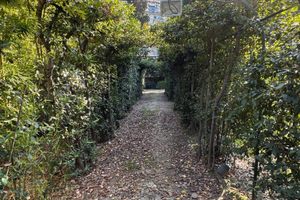
King George and Queen Olga of Greece welcomed the birth of their son, Crown Prince Constantine, in 1868. As the first member of the royal family to be born in Greece, his arrival was met with widespread excitement and national pride. After his birth the renowned architect Ernst Ziller, the official court architect of King George, was commissioned to design and construct a new residence for the crown prince. Constantine married Princess Sophia of Prussia in 1889. Construction of the palace began in 1891 and was completed in 1897.
Following the palace’s completion, work began on the surrounding gardens. What initially served as a vegetable garden gradually transformed into a grand ornamental landscape covering 25,000 square meters (about six acres). This, too, was designed by Ziller, further showcasing his architectural and aesthetic influence on the royal estate.
The garden was divided into two expansive sections — an upper and a lower tier. The upper tier, where the palace was located, had a small garden. The lower, larger tier was bisected by a wide pathway leading to a grand pond that served as a sanctuary for various species of water birds. A large pavilion was also constructed in this section, adding to its grandeur and function.
Over 140 plant species were introduced into the garden, including a diverse selection of climbing plants, flowering varieties, shrubs, lindens, plane trees, palm trees, and other vegetation, all thoughtfully arranged among manicured grass beds. Many of these specimens are rare and predominantly native to Greece, highlighting the garden’s botanical richness. Scattered throughout the landscape were ancient artifacts, seamlessly blending history, nature, and design.
Following the assassination of King George in 1913, Constantine ascended to the throne, and the palace became the official residence of the new king and queen. In 1924, the monarchy was abolished, and the building was repurposed as the presidential mansion. The monarchy was restored in 1935, returning the grounds to royal use once again. However, this period of stability was interrupted in 1941 with the Nazi invasion.
The occupying forces took control of the grounds until they retreated in 1944. After the war, the estate was returned to the monarchy and remained under royal control until 1967, when a right-wing military junta seized power in Greece. The junta leaders occupied the grounds until 1974, after which it became the official residence of the president of the Hellenic Republic.
Up until 1974, the gardens remained largely unchanged since their original construction. But after the return of democratic governance, several modifications were introduced. A broad marble staircase was added, improving access to the lower tier of the garden, and various pieces of modern art were installed throughout the grounds, subtly blending contemporary aesthetics with the garden’s historic charm. Many of the garden’s towering palms and slender cypresses have stood for more than a century, bearing silent witness to the turbulent tides of history.
In 1972, both the mansion and its gardens were officially designated as historical monuments. Today, this secluded green space — tucked away in the heart of a vibrant city — offers a peaceful retreat. It is a perfect place to relax and take in the serenity, especially on a quiet Sunday afternoon.
0 comments:
Post a Comment